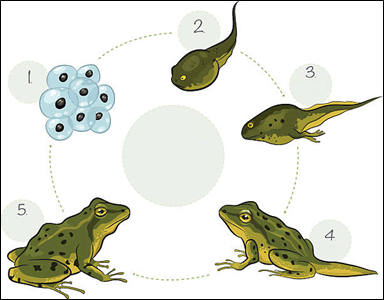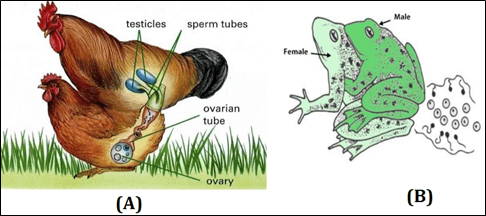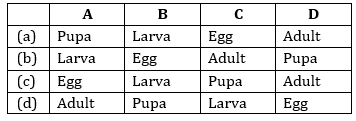Reproduction In Animals Worksheet
Objective Type Questions
- >
- Complete the paragraph by choosing the most appropriate terms from those given in the brackets.
(testes, uterus, fertilisation, zygote, ovaries, implantation, embryo, foetus)
In humans, the male reproductive organs called the ……………….. produce sperms while the female reproductive organs called the ……………….. produce eggs. When the sperms come in contact with the egg, one of the sperms fuses with the egg to form the ………………… Such fusion of the egg and the sperm is called ……………….. The zygote divides repeatedly to form a structure called the ………………… This structure gets embedded in the ……………….. for further development. - Classify the given animals as oviparous and viviparous animals.

- Complete the figure by choosing the appropriate labels given in brackets.
(adult frog, eggs, early tadpole, froglet, late tadpole)
- Which of the following indicates sexual reproduction?
(a)Fragmentation of algae into smaller fragments, each developing into new algae.
(b)Growth of a potato plant from a piece of potato with eye sown into wet and loamy soil.
(c)Transfer of pollen grains from one flower to the stigma of another flower of the same kind.
(d)Formation of a bud in yeast, which develops and separates from the body of the parent yeast. - Animals and plants can reproduce through sexual as well as asexual modes of reproduction. Which of the following is true with respect to both these methods?
(a)Sexual reproduction requires an interaction between two different animals, while asexual reproduction requires an interaction between animals of the same kind.
(b)Sexual reproduction requires an interaction between the opposite sexes of animals of the same kind, while in asexual reproduction such an interaction is not required.
(c)Sexual reproduction requires an interaction between opposite sexes of two different animals, while in asexual reproduction animals of the same kind interact.
(d)Sexual reproduction requires an interaction between the gametes of two different animals, while in asexual reproduction gametes of the animals of the same kind interact. - A reproductive process is shown below. What is characteristic of this process?

(a)Release of the egg from the ovaries
(b)Attachment of the egg to the wall of the uterus
(c)Fusion of the sperm and the ovum
(d)Transfer of ovum through the oviduct - Given below are few statements about a foetus.
I.All body parts can be identified properly.
II.It is covered by a hard shell of protective layers.
III.It resembles a large ball made of millions of cells.
Which of these statements are true?
(a) I and II
(b) Only I
(c) Only III
(d) II and III - Which of these is true about external fertilization and internal fertilization?

- The picture shows the basic parts of a salmon fish sperm. Which part of the sperm helps it to swim in water and reach the egg?

(a) A
(b) B
(c) C
(d )D - Given below are the steps involved in embryo formation.
I - The embryo develops body parts.
II - The zygote divides repeatedly to give rise to a ball of cells.
III - The cells form groups that develop into different tissues and organs of the body.
IV - The embryo gets embedded in the wall of the uterus for further development.
Which of the following gives the correct order of the steps.
(a)I, II, III, IV
(b)II, III, IV, I
(c)III, II, I, IV
(d)III, I, IV, II - Which example can be used to differentiate between a viviparous and an oviparous animal?
(a)Hens lay eggs which hatch into chicks, while cats produce kittens.
(b)Frogs lay soft-shelled eggs, while birds lay hard-shelled eggs.
(c)Frogs lay unfertilized eggs in water, while hens lay fertilized eggs.
(d)Dogs give birth to several puppies, while elephants give birth to just one calf. - The pictures show three types of reproduction in animals.

Which of the following statements is true?
(a)Type 1 reproduction is called binary fission.
(b)Type 2 reproduction produces two non-identical offspring.
(c)Type 3 reproduction involves unequal distribution of genetic material.
(d)Types 1, 2 and 3 methods of reproduction involve single parent only.
Subjective Questions - The given figure shows two different types of gametes produced in humans.

(a)Identify A and B and mention the sex – male or female in which they are found.
(b)Give two points of differences between A and B.
(c)What is the role of tail in B? - Rishabh’s science teacher planned to teach the concept of fertilisation in class. She told her students to go through the textbook to get an idea of the concept. At home, while flipping through the science textbook, Rishabh saw two pictures A and B as shown below. He went ahead and read more information about them.

(a)Which processes are shown in figures A and B respectively?
(b)How are the two processes different from one another?
(c)Name two organisms which reproduce by the process shown in figure B.
- The picture shows two different methods of reproduction in animals.

(a)Which methods are illustrated in figures A and B respectively?
(b)Are these sexual or asexual methods of reproduction? Explain your answer.
(c)Give two examples each of organisms which reproduce by methods A and B.
(d)Which structure is formed in method A which gives rise to new individuals? - Students of Class 8 went on a trip to a nearby lake. While approaching the lake, they saw a frog surrounded by hundreds of eggs, sitting on a rock near the lake. They all got scared and immediately called their teacher. When the teacher saw this sight, she told the students that those were frog eggs. Why do you think the frog must have laid so many eggs?
Case-Based Questions - In animals, males and females have different reproductive organs. These organs produce gametes which fuse to form a zygote. It is the zygote which develops into a new individual. The below image shows the reproductive system in females. Observe the image carefully and answer the questions based in it.

a) A mature egg and a sperm unite to form a zygote. In which part of the female reproductive system does a zygote form?
(a) P
(b) Q
(c) R
(d) S
b) How many eggs are usually released each month by the ovary of a woman?
(a) 1
(b) 2
(c) 14
(d) 24
c) In which part of the female reproductive system does an embryo implant?
(a) P
(b) Q
(c) R
(d) S
d) A single cell is a cell which can perform all basic functions. Which of the following represent single cells?
(a) Human sperm
(b) Egg of an ostrich
(c) White blood cells
(d) All of these - The young one of a hen that hatches from the egg looks like the adult hen. In contrast, the young one of a frog looks very different from the adult frog. Amphibians like frogs and insects like the butterfly and silkworm undergo several stages before they mature and become adults. Each of these stages vary in appearance and characteristics.
The picture below shows the life cycle of a moth.
a)Which of the following correctly lists the different stages in the life cycle of a moth?
(a) PupaLarvaEggAdult
(b) LarvaEggAdultPupa
(c) EggLarvaPupaAdult
(d) AdultPupaLarvaEgg
b)The transformation of the larva into an adult through drastic changes is called ……………………..
c)Which of the following has a life cycle similar to a moth?
(a) Silkworm and hen
(b) Silkworm and frog
(c) Frog and hen
(d) Hen and horse
d)Which of the following can be concluded from the given picture?
I - Moth is an oviparous animal.
II - A moth looks different in each stage of its life cycle.
III - There are two different stages in the life cycle of a moth.
(a) I and II
(b) II and III
(c) I and III
(d) I, II and III
Assertion-Reasoning Questions
Below questions consist of two statements – Assertion (A) and Reason (R). Answer these questions selecting the appropriate option given below:
- Assertion (A): In markets, eggs of birds are available, but eggs of cow are never available.
Reason (R): Birds are oviparous while cow is a viviparous animal. - Assertion (A): Though Dolly was given birth by the Scottish blackface ewe, it was found to be identical to the Finn Dorsett sheep.
Reason (R): The nucleus of Finn Dorsett sheep was inserted into the egg of the Scottish blackface ewe whose nucleus had been removed.
Explore more Science Sample papers and Solutions
- Crop Production And Management Worksheet
- Microorganisms: Friend And Foe Worksheet
- Coal And Petroleum Worksheet
- Combustion And Flame Worksheet
- Conservation Of Plants And Animals Worksheet
- Reaching the Age of Adolescence Worksheet
- Force And Pressure Worksheet
- Friction Worksheet
- Sound Worksheet
- Chemical Effects of Electric Current Worksheet
- Some Natural Phenomena Worksheet
- Light Worksheet
-
Competency Based Questions for CBSE Class 8 Science
- Synthetic Fibres and Plastics Model Paper
- Materials: Metals and Non-Metals Model Paper
- Coal and Petroleum Model Paper
- Combustion and Flame Model Paper
- Conservation of Plants and Animals Model Paper
- Cell - Structure and Functions Model Paper
- Reproduction in Animals Model Paper
- Reaching the Age of Adoloscence Model Paper
- Force and Pressure Model Paper
- Friction Model Paper
- Sound Model Paper
- Chemical Effects of Electric Current Model Paper
- Some Natural Phenomena Model Paper
- Light Model Paper
- Stars and the Solar System Model Paper
- Pollution of Air and Water Model Paper
Key Features of CBSE Class 8 Science:
- Prepared by subject matter experts
- According to the latest CBSE syllabus
- Helpful when doing homework
- Easy to understand
- Helpful for quick revision
- Score more marks in the examination
- Free textbook solutions & doubt-solving sessions
- Increase paper-solving speed
- Improvement in marks





